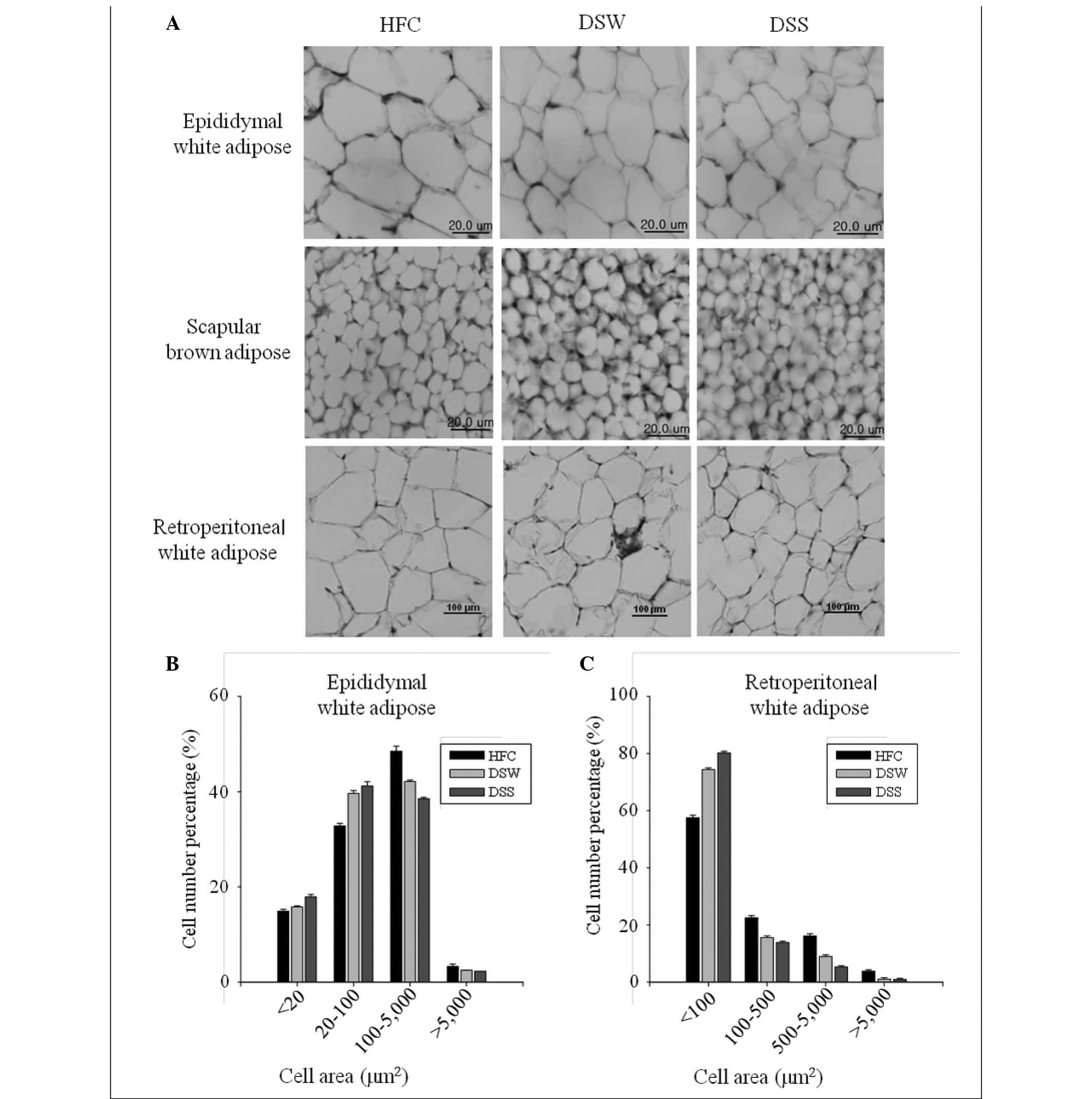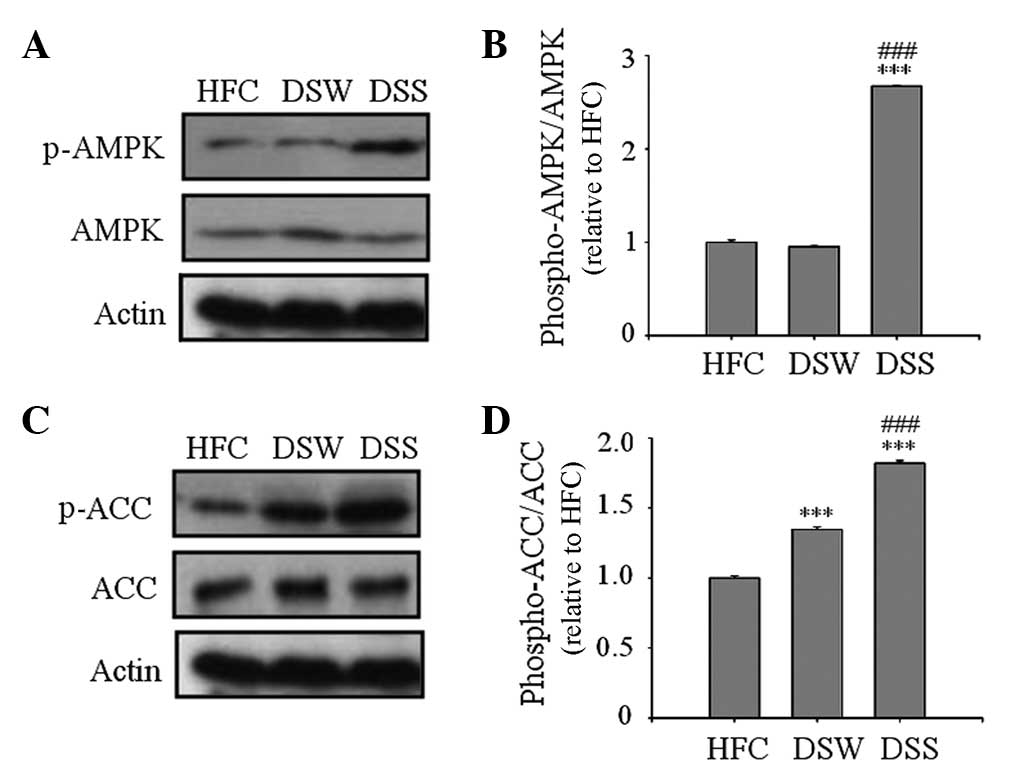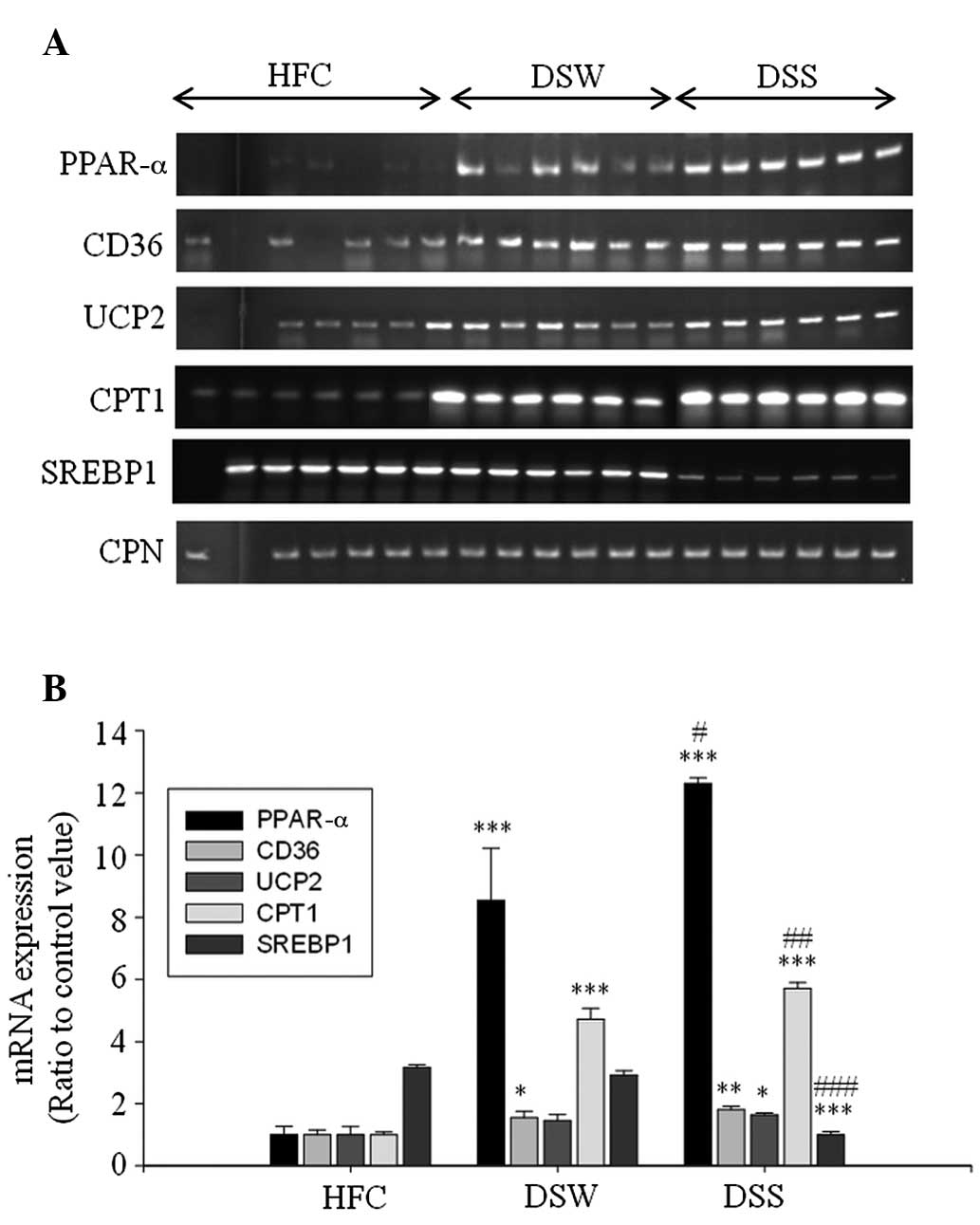|
1
|
Kopelman PG: Obesity as a medical problem.
Nature. 404:635–643. 2000.PubMed/NCBI
|
|
2
|
Ahn J, Lee H, Kim S, Park J and Ha T: The
anti-obesity effect of quercetin is mediated by the AMPK and MAPK
signaling pathways. Biochem Biophys Res Commun. 373:545–549. 2008.
View Article : Google Scholar : PubMed/NCBI
|
|
3
|
Hill JO and Peters JC: Environmental
contributions to the obesity epidemic. Science. 280:1371–1374.
1998. View Article : Google Scholar : PubMed/NCBI
|
|
4
|
Beck B: Neuropeptides and obesity.
Nutrition. 16:916–923. 2000. View Article : Google Scholar : PubMed/NCBI
|
|
5
|
Woods SC, Seeley RJ, Rushing PA, D'Alessio
D and Tso P: A controlled high-fat diet induces an obese syndrome
in rats. J Nutr. 133:1081–1087. 2003.PubMed/NCBI
|
|
6
|
Woo MN, Bok SH, Lee MK, Kim HJ, Jeon SM,
Do GM, Shin SK, Ha TY and Choi MS: Anti-obesity and hypolipidemic
effects of a proprietary herb and fiber combination (S&S PWH)
in rats fed high-fat diets. J Med Food. 11:169–178. 2008.
View Article : Google Scholar : PubMed/NCBI
|
|
7
|
Okamoto Y, Higashiyama H, Rong JX, McVey
MJ, Kinoshita M, Asano S and Hansen MK: Comparison of mitochondrial
and macrophage content between subcutaneous and visceral fat in
db/db mice. Exp Mol Pathol. 83:73–83. 2007. View Article : Google Scholar : PubMed/NCBI
|
|
8
|
Shono M, Shimizu I, Aoyagi E, Taniguchi T,
Takenaka H, Ishikawa M, Urata M, Sannomiya K, Tamaki K, Harada N,
et al: Reducing effect of feeding powdered nacre of Pinctada
maxima on the visceral fat of rats. Biosci Biotechnol Biochem.
72:2761–2763. 2008. View Article : Google Scholar : PubMed/NCBI
|
|
9
|
Hainer V, Toplak H and Mitrakou A:
Treatment modalities of obesity: What fits whom? Diabetes Care.
31:269–277. 2008. View Article : Google Scholar
|
|
10
|
Derosa G, Cicero AF, Murdolo G, Piccinni
MN, Fogari E, Bertone G, Ciccarelli L and Fogari R: Efficacy and
safety comparative evaluation of orlistat and sibutramine treatment
in hypertensive obese patients. Diabetes Obes Metab. 7:47–55. 2005.
View Article : Google Scholar : PubMed/NCBI
|
|
11
|
Hwang HS, Kim SH, Yoo YG, Chu YS, Shon YH,
Nam KS and Yun JW: Inhibitory effect of deep-sea water on
differentiation of 3T3-L1 adipocytes. Mar Biotechnol. 11:161–168.
2009. View Article : Google Scholar : PubMed/NCBI
|
|
12
|
Hataguchi Y, Tai H, Nakajima H and Kimata
H: Drinking deep-sea water restores mineral imbalance in atopic
eczema/dermatitis syndrome. Eur J Clin Nutr. 59:1093–1096. 2005.
View Article : Google Scholar : PubMed/NCBI
|
|
13
|
Katsuda S, Yasukawa T, Nakagawa K, Miyake
M, Yamasaki M, Katahira K, Mohri M, Shimizu T and Hazama A:
Deep-sea water improves cardiovascular hemodynamics in Kurosawa and
Kusanagi-Hypercholesterolemic (KHC) rabbits. Biol Pharm Bull.
31:38–44. 2008. View Article : Google Scholar : PubMed/NCBI
|
|
14
|
Hwang HS, Kim HA, Lee SH and Yun JW:
Anti-obesity and antidiabetic effects of deep sea water on ob/ob
mice. Mar Biotechnol (NY). 11:531–539. 2009. View Article : Google Scholar : PubMed/NCBI
|
|
15
|
Ha BG, Park JE, Shin EJ and Shon YH:
Effects of balanced deep sea water on adipocyte hypertrophy and
liver steatosis in high-fat diet induced obese mice. Obesity
(Silver Spring). 22:1669–1678. 2014. View Article : Google Scholar : PubMed/NCBI
|
|
16
|
Hahm TS, Park SJ and Martin Lo Y: Effects
of germination on chemical composition and functional properties of
sesame (Sesamum indicum L.) seeds. Bioresour Technol.
100:1643–1647. 2009. View Article : Google Scholar : PubMed/NCBI
|
|
17
|
Lee J, Kausar T and Kwon JH:
Characteristic hydrocarbons and 2-alkylcyclobutanones for detecting
gamma-irradiated sesame seeds after steaming, roasting and oil
extraction. J Agric Food Chem. 56:10391–10395. 2008. View Article : Google Scholar : PubMed/NCBI
|
|
18
|
Institute of Laboratory Animal Research.
Commission on Life Sciences and National Research Council: Guide
For The Care And Use Of Laboratory Animals (Washington, DC).
National Academy Press. 1–136. 1996.
|
|
19
|
Yin HQ, Kim M, Kim JH, Kong G, Kang KS,
Kim HL, Yoon BI, Lee MO and Lee BH: Differential gene expression
and lipid metabolism in fatty liver induced by acute ethanol
treatment in mice. Toxicol Appl Pharmacol. 223:225–233. 2007.
View Article : Google Scholar : PubMed/NCBI
|
|
20
|
Horton JD, Goldstein JL and Brown MS:
SREBPs: Activators of the complete program of cholesterol and fatty
acid synthesis in the liver. J Clin Invest. 109:1125–1131. 2002.
View Article : Google Scholar : PubMed/NCBI
|
|
21
|
Hardie DG: The AMP-activated protein
kinase pathway - new players upstream and downstream. J Cell Sci.
117:5479–5487. 2004. View Article : Google Scholar : PubMed/NCBI
|
|
22
|
Jeon JR and Kim JY: Effects of pine needle
extract on differentiation of 3T3-L1 preadipocyte. Biol Pharm Bull.
29:2111–2115. 2006. View Article : Google Scholar : PubMed/NCBI
|
|
23
|
Jun HS, Hwang K, Kim Y and Park T:
High-fat diet alters PP2A, TC10 and CIP4 expression in visceral
adipose tissue of rats. Obesity (Silver Spring). 16:1226–1231.
2008. View Article : Google Scholar : PubMed/NCBI
|
|
24
|
Saito M, Ueno M, Ogino S, Kubo K, Nagata J
and Takeuchi M: High dose of Garcinia cambogia is effective in
suppressing fat accumulation in developing male Zucker obese rats,
but highly toxic to the testis. Food Chem Toxicol. 43:411–419.
2005. View Article : Google Scholar : PubMed/NCBI
|
|
25
|
Ogawa Y, Masuzaki H, Ebihara K, Shintani
M, Aizawa-Abe M, Miyanaga F and Nakao K: Pathophysiogical role of
leptin in lifestyle-related diseases: Studies with transgenic
skinny mice overexpressing leptin. J Diabetes Complications.
16:119–122. 2002. View Article : Google Scholar : PubMed/NCBI
|
|
26
|
Hardie DG and Carling D: The
AMPK-activated protein kinase-fuel gauge of mammalian cells. Eur J
Biochem. 246:259–273. 1998. View Article : Google Scholar
|
|
27
|
Hardie DG, Carling D and Carlson M: The
AMP-activated/SNF1 protein kinase subfamily: Metabolic sensors of
the eukaryotic cell? Ann Rev Biochem. 67:821–855. 1998. View Article : Google Scholar : PubMed/NCBI
|
|
28
|
Hardie DG, Scott JW, Pan DA and Hudson ER:
Management of cellular energy by energy by the AMP-activated
protein kinase system. FEBS Lett. 546:113–120. 2003. View Article : Google Scholar : PubMed/NCBI
|
|
29
|
Yano W, Kubota N, Itoh S, Kubota T,
Awazawa M, Moroi M, Sugi K, Takamoto I, Ogata H, Tokuyama K, et al:
Molecular mechanism of moderate insulin resistance in
adiponectin-knockout mice. Endocr J. 55:515–522. 2008. View Article : Google Scholar : PubMed/NCBI
|
|
30
|
Janovská A, Hatzinikolas G, Staikopoulos
V, McInerney J, Mano M and Wittert GA: AMPK and ACC
phosphorylation: Effect of leptin, muscle fibre type and obesity.
Mol Cell Endocrinol. 284:1–10. 2008. View Article : Google Scholar : PubMed/NCBI
|
|
31
|
Velasco G, Geelen MJ and Guzmán M: Control
of hepatic fatty acid oxidation by 5′-AMP-activated protein kinase
involves a malonyl-CoA-dependent and a malonyl-CoA-independent
mechanism. Arch Biochem Biophys. 337:169–175. 1997. View Article : Google Scholar : PubMed/NCBI
|

















